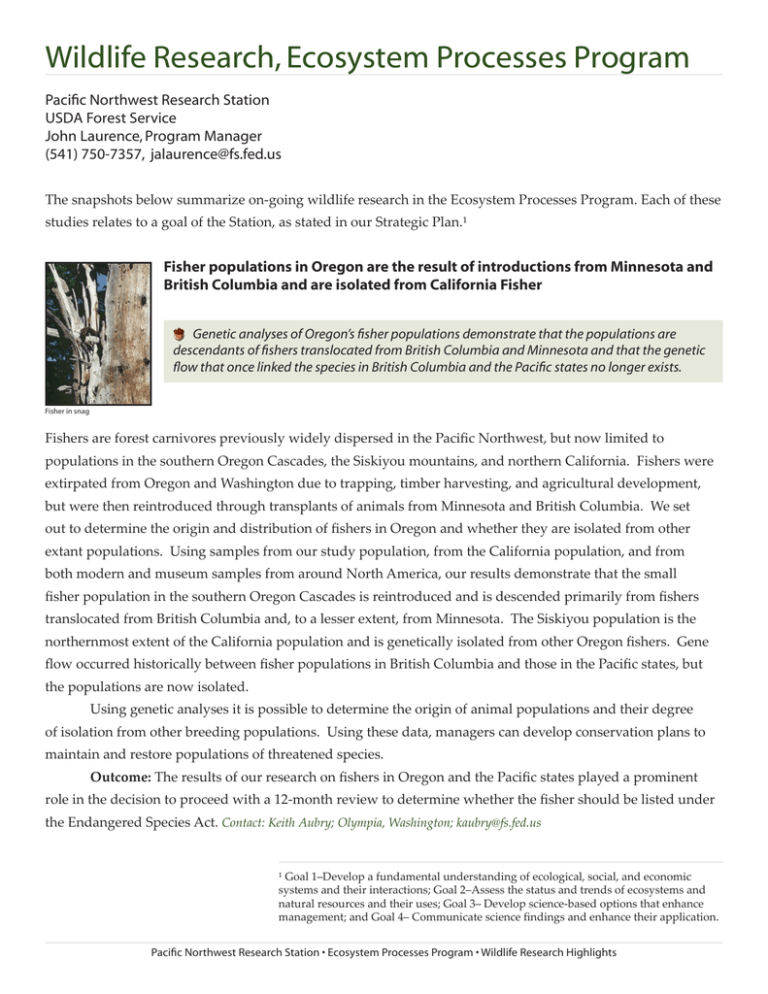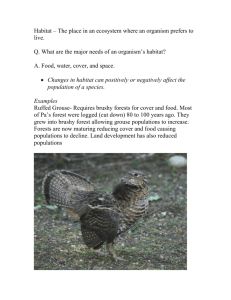Wildlife Research, Ecosystem Processes Program
advertisement

Wildlife Research, Ecosystem Processes Program Pacific Northwest Research Station USDA Forest Service John Laurence, Program Manager (541) 750-7357, jalaurence@fs.fed.us The snapshots below summarize on-going wildlife research in the Ecosystem Processes Program. Each of these studies relates to a goal of the Station, as stated in our Strategic Plan.¹ Fisher populations in Oregon are the result of introductions from Minnesota and British Columbia and are isolated from California Fisher Genetic analyses of Oregon’s fisher populations demonstrate that the populations are descendants of fishers translocated from British Columbia and Minnesota and that the genetic flow that once linked the species in British Columbia and the Pacific states no longer exists. Fisher in snag Fishers are forest carnivores previously widely dispersed in the Pacific Northwest, but now limited to populations in the southern Oregon Cascades, the Siskiyou mountains, and northern California. Fishers were extirpated from Oregon and Washington due to trapping, timber harvesting, and agricultural development, but were then reintroduced through transplants of animals from Minnesota and British Columbia. We set out to determine the origin and distribution of fishers in Oregon and whether they are isolated from other extant populations. Using samples from our study population, from the California population, and from both modern and museum samples from around North America, our results demonstrate that the small fisher population in the southern Oregon Cascades is reintroduced and is descended primarily from fishers translocated from British Columbia and, to a lesser extent, from Minnesota. The Siskiyou population is the northernmost extent of the California population and is genetically isolated from other Oregon fishers. Gene flow occurred historically between fisher populations in British Columbia and those in the Pacific states, but the populations are now isolated. Using genetic analyses it is possible to determine the origin of animal populations and their degree of isolation from other breeding populations. Using these data, managers can develop conservation plans to maintain and restore populations of threatened species. Outcome: The results of our research on fishers in Oregon and the Pacific states played a prominent role in the decision to proceed with a 12-month review to determine whether the fisher should be listed under the Endangered Species Act. Contact: Keith Aubry; Olympia, Washington; kaubry@fs.fed.us ¹ Goal 1–Develop a fundamental understanding of ecological, social, and economic systems and their interactions; Goal 2–Assess the status and trends of ecosystems and natural resources and their uses; Goal 3– Develop science-based options that enhance management; and Goal 4– Communicate science findings and enhance their application. Pacific Northwest Research Station • Ecosystem Processes Program • Wildlife Research Highlights Marbled murrelet populations are affected by habitat quality, fragmentation, and predation of nests The abundance and reproductive success of the marbled murrelet is affected by the quality and continuity of its habitat and the presence of nest predators. Marbled murrelet The marbled murrelet (Brachyramphus marmoratus) is a threatened seabird that nests on branches of large trees within older coniferous forest in coastal areas of the Pacific Northwest. Surveys suggest that murrelets o�en nest in continuous stands of mature, complexly structured forest but they also nest in younger forest and in stands varying in size from just a few to thousands of acres. We examined how murrelet abundance and reproduction are related to the amount and pa�ern of nesting habitat at regional, watershed, landscape, and nest-site scales. At the regional scale, abundance of murrelets, estimated from offshore surveys, was found to be correlated with amount of nesting habitat in some areas and to a lesser extent with fragmentation of that habitat. We found a similar pa�ern at the watershed scale. At the scale of nest sites and surrounding landscapes, fragmentation may have greater effect on likelihood of nesting and nest success, perhaps due to increased predation by birds such as crows and jays. Over the past 5 years we tested this assumption in Washington using artificial nests located in stands of varying structural complexity, levels of fragmentation, and proximity to human activity. Results indicate, first, that a broad suite of predators, including at least 10 mammalian and avian species, prey on simulated eggs and chicks. Second, rates of predation are higher within 50 yards of forest edge but this relationship varies with proximity to human activity and with the structure of the adjacent regenerating forest. Predation increased with proximity to forest edges when the matrix contained human se�lements and recreation areas, but not when it was dominated by regenerating forests. Using these results, we are developing a model to predict likely murrelet habitat and survival that will allow forest managers to assess the potential impact of management activities on the bird. Outcome: Based on our understanding of murrelet biology, land managers can develop conservation strategies over mixed-ownership landscapes. Contact: Martin Raphael; Olympia, Washington; mraphael@fs.fed.us The northern flying squirrel serves as a model for understanding conservation genetics and ecosystem roles across wide geographical areas Northern flying squirrel Findings show that the genetic diversity of northern flying squirrels may serve as a gauge of the effects of forest management practices and that in Alaska, the species’ diet is much more generalized than that of its counterparts in the Pacific Northwest. Forests around the world are becoming simpler due to forest management techniques. In the face of this, it is important to understand the impact of simplification on vegetation and wildlife. Research on the genetic diversity and variability of species like the flying squirrel may lead to new developments in forest management strategies, particularly in areas of mixed ownership and development where fragmentation may isolate populations. In studies conducted in Washington, northern flying squirrel populations were used to evaluate the effects of forest management on genetic heterogeneity. Squirrel populations may become Pacific Northwest Research Station • Ecosystem Processes Program • Wildlife Research Highlights genetically isolated if open spaces interrupt forest cover. Maintenance of genetic diversity can be achieved a�er certain management activities such as light, variable-density thinnings, but may require sufficient undisturbed forest adjacent to thinnings for recolonization. Complex forests may help promote permeability of managed landscapes, thus, maintaining gene flow. Similar studies are proposed in Alaska where forest conditions are not affected by human development activities. Our research has also shown that the diet of the northern flying squirrel in southeast Alaska differs importantly from that of the northern flying squirrel in the Pacific Northwest—it is more general and not as focused on truffles as that in the Pacific Northwest. This dietary difference may have implications for habitat relations―Alaska squirrels may be able to exploit a wider variety of habitats than can squirrels in the Pacific Northwest. However, flying squirrels remain an important vector for truffle spores in Alaska. Outcome: Genetic analysis allows evaluation of the effects of fragmentation on animal populations. Contacts: Todd Wilson; Olympia, Washington; twilson@fs.fed.us; and Winston Smith; Juneau, Alaska; wsmith02@fs.fed.us Predicting abundance and demographic performance of northern spotted owls Early assessments indicate that it may be possible to predict the presence or absence of northern spotted owls in a landscape by analyzing the amount and pattern of the area’s vegetation. Northern spotted owl Traditionally, on-the-ground surveys have been used to track populations of the northern spo�ed owl (NSO) and to assess the effectiveness of its recovery plan. Such surveys are expensive and time-consuming to conduct and may be disruptive to the owls. Our objective was to determine if it is possible to predict survival rates, reproductive rates, or site occupancy of NSO based on the type and amount of forest vegetation present at a particular site. Based on analyses of data from near Roseburg, Oregon, at the H. J. Andrews Experimental Forest, and in the Coast Range, our results suggest that it is difficult to predict survival and productivity of owls based on vegetation a�ributes alone, because weather conditions, age of owls, and presence or absence of barred owls have a strong influence as well. We are now focusing on new methods of analysis that consider occupancy—the presence or absence of owls at a particular site—in relation to vegetation a�ributes. Our preliminary assessment of these methods indicates that models based on occupancy seem to be more accurate. Outcome: Success in modeling NSO survival, reproduction, and occupancy will allow on-the-ground monitoring of owls to be replaced by estimating the status of owl populations based on the amount and distribution of vegetation present at a given site. Spotted owl update: natal and breeding dispersal and speciation In 2003 we published a Wildlife Monograph on natal and breeding dispersal of northern spo�ed owls based on 15 years of capture-recapture data from demographic studies in Washington and Oregon. This monograph includes the most extensive data set ever collected on dispersal of any species of owl in the world, and Pacific Northwest Research Station • Ecosystem Processes Program • Wildlife Research Highlights represents a significant contribution to the literature on avian dispersal. We are also using genetic analyses to study the speciation of the spo�ed owl. This study supports the traditional subdivision of the spo�ed owl into three subspecies, but also indicates a broad contact zone between the northern spo�ed owl (Strix occidentalis caurina) and California spo�ed owl (S. o. occidentalis) in northern California and southern Oregon. Outcome: Population studies and genetic analyses will be used by the US Fish and Wildlife Service in its re-examination of the status of the northern spo�ed owl. Contact: Eric Forsman; Corvallis, Oregon; eforsman@fs.fed.us Taxonomic identity and daily and seasonal movements of red tree voles Studies show that two subspecies of red tree vole are not valid and that the species tends to maintain its movement and habitat use patterns across seasons. Red tree voles Red tree voles are unique arboreal mice that occur only in Oregon and northern California. Red tree voles are also a primary food for northern spo�ed owls. There is considerable confusion over the taxonomy, ecology, and behavior of voles, information critical to efforts to manage the vole complex. We used tissues of red tree voles to unravel the taxonomy and to examine the genetic structure of populations. First we used tissue from bone, skin, muscle, and organs to evaluate relationships between tree voles and their relatives in the genus Phenacomys and to evaluate sub-specific relationships. Our results indicate that Phenacomys longicaudus and P. pomo are valid species, but that P. l. silvicola and P. l. longicaudus are not valid subspecies. In further work, we radio-tracked voles to investigate movements and behavior of the animals and to compare their behavior in old forests versus young forests. The use of radio-telemetry has allowed us to document use of multiple nests in different trees and to characterize both ground and tree-to-tree movements. Thus far we have found li�le evidence of significant seasonal differences in movements or habitat use of tree voles. No use of ground nests has been detected but occasional use of cavity nests has been documented. Outcome: Understanding the taxonomy of the red tree vole will lead to a clearer definition of what populations may need protection. Documenting the behavior of the vole allows managers to assess the likely impact of on-the-ground activities on the preferred prey of northern spo�ed owls. Contact: Eric Forsman; Corvallis, Oregon; eforsman@fs.fed.us Amphibians and mammals occurring in and along headwater streams may reveal forest management strategies after a pre- and post-treatment harvest experiment Giant salamander Giant salamander – photo by Larry Jones A study examining the abundance and diversity of amphibians and semi-aquatic mammals before a forest harvest experiment shows that only two species of salamanders are common in-stream residents. In collaboration with the Washington Department of Natural Resources (DNR) and the Aquatic and Land Interactions program (ALI), we began research in western Washington to compare the abundance and diversity of small vertebrates during the pre-treatment period of a forest harvest and small stream buffer Pacific Northwest Research Station • Ecosystem Processes Program • Wildlife Research Highlights experiment on lands managed by DNR. This headwater stream management options research supports efforts to develop a long-term Type 5 or 1st order stream conservation strategy as part of DNR’s Habitat Conservation Plan, and to support DNR’s proposed adaptive management strategy. We are sampling along or within 23 streams in 6 study sites, with 3 in the Willapa Hills and 3 in the Black Hills. Each site has 3-5 streams designated to receive control, no buffer, narrow fixed width, and variable width or patch buffer treatments. The same streams will be sampled, post-harvest, to determine any effects of the treatments. We designed sampling to target 4 stream-dwelling amphibians (tailed frog, Columbia torrent salamander, and Cope’s and coastal giant salamanders); 4 near-stream terrestrial amphibians (western redbacked, Ensatina, VanDyke’s and Dunn’s salamanders); and 2 species of semi-aquatic shrews (water and marsh shrews). One invertebrate, the signal crayfish, is also being studied. Ten of the 11 focal species have been recorded. Only the torrent and giant salamanders appear to be “common” in-stream vertebrates – and only in the Willapa Hills. Outcome: These results will be used by land managers throughout the region to design harvest prescriptions. Contact: Martin Raphael; Olympia, Washington; mraphael@fs.fed.us Understanding the role of salmon in productivity of riparian ecosystems Nutrients derived from salmon make up a large portion of those plants and animals living in aquatic and terrestrial habitats associated with salmon populations. Riparian ecosystem We reviewed findings of recent research on the ecological role of salmon in riparian ecosystems of the North Pacific Coast. Salmon are a major food resource for terrestrial and aquatic carnivores, scavengers, and decomposers. They also function as a major nutrient subsidy to freshwater streams and riparian vegetation. Salmon-derived nutrients make up a substantial fraction of the plants and animals in aquatic and terrestrial habitats associated with productive salmon populations. Benefits of this new, increased knowledge lie in a be�er understanding of the complex relationships between streams, forests, salmon, and ecosystem productivity, enabling land managers to be�er conserve such important ecological processes. The information is especially useful to land managers wherever significant freshwater salmon runs occur. Outcome: Considerable debate occurs over the importance of marine-derived nutrients in aquatic and riparian systems. The results of this study apply directly to that debate. Contact: Sco� Gende, National Park Service, Sco�_Gende@nps.gov; and Tom Hanley; Juneau, Alaska; thanley@fs.fed.us. Note: This research was conducted before and during the transition of the Alaska Wildlife Habitat Team from the Aquatic and Land Interactions program (ALI) to ECOP. Pacific Northwest Research Station • Ecosystem Processes Program • Wildlife Research Highlights



